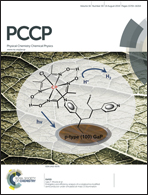Intermolecular interactions between a Ru complex and organic dyes in cosensitized solar cells: a computational study†
Abstract
Intermolecular interactions in cyclometalated Ru complex dye (FT89) dimers, carbazole organic dye (MK-45 and MK-111) dimers, FT89–MK-45 complexes, and FT89–MK-111 complexes were investigated using density functional theory (DFT) and time-dependent DFT (TD-DFT) to elucidate the improvement mechanism of dye-sensitized solar cell (DSSC) performance due to cosensitization with FT89 and MK dyes. All of the dimers and complexes form intermolecular cyclic hydrogen bonds via the carboxyl groups. The FT89 dimer and complexes with the TiO2Na model system promote intermolecular interactions with I2via the NCS ligand of the FT89 monomer. The computational results verify that MK-111 behaves not only as a sensitizer but also inhibits FT89 aggregation by effectively serving as a coadsorbent similar to deoxycholic acid (DCA) in the dye solution, suppressing recombination of the injected electrons in TiO2 with I2, improving DSSC performance.


 Please wait while we load your content...
Please wait while we load your content...